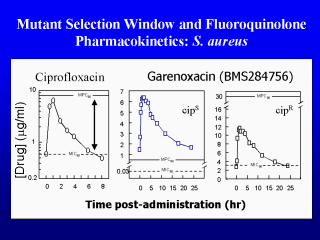 |
We will consider the effects of
a new quinolone called garenoxacin (see slide 33 for structure). Recall that with S.
aureus ciprofloxacin concentrations fall right in the center of the selection window
(panel A) and resistance developed readily. Garenoxacin is much more active, and it is
well above the window with ciprofloxacin-susceptible (wild-type strains, panel B). The
compound is so good that some authors have expressed optimism about using it with
ciprofloxacin-resistant MRSA. If you only consider the MIC, that is a reasonable
statement. However, when you determine MPC for cipro-resistant MRSA, you see that the
curve looks just like the one for ciprofloxacin and wild-type cells. Thus garenoxacin is
likely to readily select resistant mutants if used with ciprofloxacin-resistant strains
(20). Getting the most out of garenoxacin will require careful attention to the
quinolone-resistance status of the strain to be treated. |
